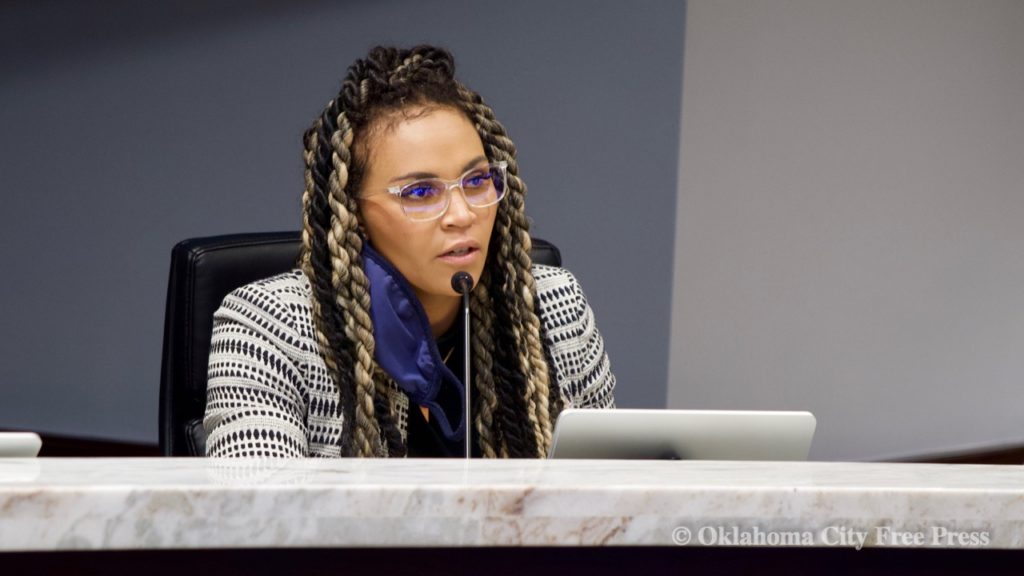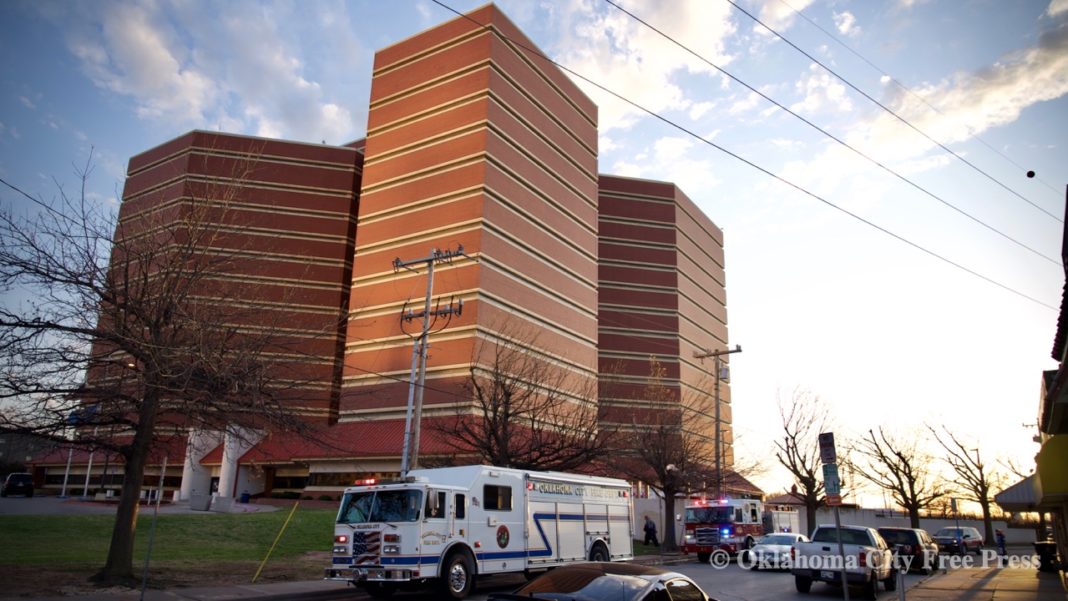Last Updated on April 7, 2021, 10:50 AM | Published: April 6, 2021
OKLAHOMA CITY (Free Press) — The Detention Center Action Committee (DCAC), a fledgling subcommittee of the Oklahoma County Criminal Justice Authority (more commonly known as the Jail Trust), met Monday to induct a slate of new committee members (see list below) and discuss goals.
The committee also continued their discussions about direct supervision in the Jail, depopulation, and how the classification system sets up the jail for overcrowding.
While Trustee Ben Brown opposed the addition of some of the new members, the whole slate was approved.
The meeting, held in person and virtually, was well attended and lasted for over two hours as new committee members and Trustees of the Authority discussed purposes and goals for the group.
Member Disagreement
The first item of new business on Monday’s agenda was to approve a slate of new members of the subcommittee. As soon as the item was introduced, Senator Ben Brown moved to approve only some of the proposed members, notably leaving out people he associated with protests that have been a regular part of Jail Trust and other County meetings over the last year.
Trustee Sue Ann Arnall said that she would second the motion only if it weren’t exclusive of the other people listed in the agenda. Trustee and Committee Chair Francie Ekwerekwu accepted the motion “as amended” by Arnall and asked for discussion on the item.
Brown said that he had already spoken his piece in the past, but reiterated that he believes it to be too large of a membership for a working group, calling the number “unmanageable.” He went on to again express his discomfort with some of the proposed members who he previously compared to insurrectionists in the U.S. Capitol on January 6, 2021.
“I also think it’s counterproductive to have some of the protestors who have encouraged some of the things that have gone on here,” Brown said, “If you read the papers today, in St. Louis you see the same kind of protestors were out there encouraging the riot.”
Ekwerekwu calmly countered, “Your comments have been heard, but we’re not here to vote on protestors in St. Louis, we’re here to vote on people listed on this agenda.”
Ekwerekwu called the vote and was joined by Arnall in voting “aye” for the slate of candidates. Brown emphatically voted “no.”
Shared Goals
After introductions, Ekwerekwu gave a brief presentation on the purpose and shared goals of the committee.
Ekwerekwu began her presentation by saying that with whatever discussions the committee may have, all members should focus on protecting and saving the lives of people who live in and work in the Detention Center.
The task of the committee, Ekwerekwu explained, was to take a deep dive into issues and make recommendations to the Trust that would move the Jail beyond the conditions that have been damaging and deadly to incarcerated persons for decades.
“We don’t have anywhere else to go from here but up. We have to move forward,” Ekwerekwu said.
Ekwerekwu then explained that the expressed purpose of the committee was to research and make recommendations to the Jail Trust in three specific areas. Those areas are direct supervision in the Jail, decreasing the Jail population, and evaluating a classification system that would better serve staff and detainees.
Direct Supervision
Direct supervision is a term of art in the industry that basically means having enough staff to provide more constant oversight of detainees. In turn, that means a healthier environment for detainees and staff. Direct supervision allows for more time spent outside of cells and easier processes for meal service and passing medications, and exercise opportunities. Furthermore, that level of supervision provides opportunities for more services and programs. All of these are shown to produce better health and safety outcomes.
During discussion Arnall said that direct supervision can reduce trauma for those who live in and those who work in the facility, and could really change the culture of the Jail.
“You don’t make a place safer by locking people down for 24 hours a day,” Arnall said.
Jail Depopulation
The Oklahoma County Detention Center opened in 1991, and was built with a capacity of approximately 1200 people. As of Monday the Jail population was 1584 with 106 waiting for transfer to Department of Corrections custody. This shows a recent downward trend in population, but with some pods closed, the Jail still has to “triple cell” some detainees. That means some detainees sleep on a “boat” on the floor of a cell with two other cell mates.
Contrary to the belief or understanding of some in the community, the Jail and the Trust are not legally able to simply release detainees. Those decisions must be made by a judge, and judges often take the word of the District Attorney’s office regarding a detainee’s readiness to return to the public.
However, as Arnall pointed out in Monday’s meeting, the Jail is legally allowed to deny access to some people. Specifically, she explained, the Jail is not required to grant access to people who are ill, whether physically or mentally. She said that most of the people who have died in the Jail have been either physically or mentally ill.

“We need to develop a method to back up our administrator as he denies access to them,” Arnall said.
Classification System
According to Arnall, the most difficult task before the committee is to find a new classification system for detainees at the Jail. The classification system is what determines if persons held at the Jail are listed as low, medium, or high-security.
Currently approximately 49% of people held at the Jail are classified as “high-security.” The classification system currently used at the Oklahoma County Jail was formed in 1998.
By contrast, the Tulsa County Jail, which has a similar sized population and a similar civic culture, lists only about 100 of their detainees as high-security.
New Members
Not every new member was present at Monday’s meeting, but those who were present had the opportunity to briefly introduce themselves to their peers. They are as follows:
-Ryan Haney, Criminal Justice Reform Fellow at the Oklahoma Council for Public Affairs
-Aaron Cosar, a person formerly incarcerated who now runs faith-based prison programs across the state
-Brandon Clabes, Midwest City Chief of Police
-Adriana Laws, Co-Founder of the Collegiate Freedom and Justice Coalition, and local activist and civic leader
-Chuck Loughlin, Investigator for the Oklahoma County Public Defender’s Office
-John Budd, COO of the State of Oklahoma, present in his role as a Community Volunteer
-Ryan Gentzler, Research Director of the Oklahoma Policy Institute, Researching OK Criminal Justice System*
-Nicole McAfee, ACLU of Oklahoma, long-time Criminal Legal Reform spokesperson
-Sara Bana, Independent Civil and Human Rights Advocate, Executive Director Civic Services Community Advocacy
-John Middendorf, Pastor, OKC First Nazarene
-Tim Tardibono, Executive Director Criminal Justice Advisory Council (CJAC)
Committee Future
Free Press spoke by phone with Adriana Laws, one of the new members added to the committee during Monday’s meeting. We asked Laws what her goals for the committee were, now that she is in a position to influence policy discussions.
“I have two main goals. First is to decrease the Jail population,” Laws said. “That will have to be a collaborative effort between the Trust, the DA, and the judges.”
“My second goal is to focus on quality of life issues in the Jail. The classification system plays into that quality of life. If we have people in the Jail classified as ‘high security,’ we can’t offer them as much programming and care as they might need.”
Laws continued, “I want to see programming expanded. Things like AA and NA. But also, working with Metro Tech to provide GED and literacy opportunities. DHS may be partnering to help incarcerated parents have regular fifteen minute phone calls with their children. These can improve the quality of life for people in the Jail.”
“I’m also focused on pretrial detainment numbers. At least 80% of people in the Jail are waiting for trial. Currently 246 people held have already been sentenced are either serving out their time at the County Jail, or awaiting transfer to DOC.”
The Detention Center Action Committee is scheduled to meet monthly, with their next meeting scheduled for May 3, at 1:00 p.m. The meetings are open to the public, and ample time for public comment is allowed.
*Update 4-7-21 – In the original version we misspelled the name of Ryan Gentzler with the Oklahoma Policy Insititute. It is corrected with our apologies to Mr. Gentzler.
Columnist covering local government in Oklahoma City and Oklahoma County from May 2019 through June 2023.










